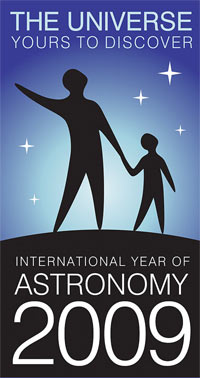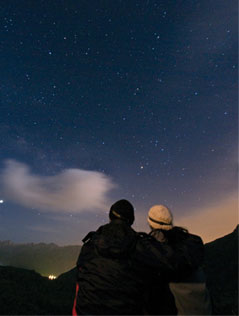World celebrates 400th anniversary of Galileo’s first astronomical observation through a telescope.
PARIS, Dec. 30, 2008 – Stargazers across the globe are gearing up for the International Year of Astronomy. A staggering 135 nations are collaborating to bring the universe closer to Earth. Events and activities will take place over the coming 365 year and beyond, in a spectacle of cosmic proportions.
 The International Year of Astronomy 2009 (IYA2009) has been launched by the International Astronomical Union (IAU) and the United Nations Educational, Scientific and Cultural Organization (UNESCO) under the theme, "The Universe, yours to discover.”
The International Year of Astronomy 2009 (IYA2009) has been launched by the International Astronomical Union (IAU) and the United Nations Educational, Scientific and Cultural Organization (UNESCO) under the theme, "The Universe, yours to discover.”
The official IYA2009 opening ceremony will take place in Paris on Jan. 15-16, and the press is invited to attend. It will feature keynote speakers, including Nobel laureates and live video feeds to scientists working in remote locations. Many countries intend to host their own opening ceremonies as well.
The IYA2009 Solar Physics Group has been busy planning a grand worldwide campaign, with more than 30 countries involved at more than 150 venues. Amateur stargazers will set up their telescopes on pavements as well as in science centers, allowing passers-by to observe the sun using special safety equipment.
The Cosmic Diary, an example of a global activity occurring during 2009, released its official Web site on New Year's Day. The project concerns the daily lives of full-time astronomers. More than 50 bloggers and professionals from more than 35 countries, some of whom are employed by organizations such as ESO, NASA, ESA and JAXA have begun producing content, writing about their lives, the work they conduct and the challenges they face. The diary allows the public to see what being an astronomer is really like and how groundbreaking research is conducted.
Another project, 365 Days of Astronomy, will publish one podcast per day over the entire year. The episodes will be written, recorded and produced by people around the world.
Another IYA2009 Cornerstone Project, 100 Hours of Astronomy, is a worldwide event taking place April 2-5, with a wide range of public outreach activities including live webcasts, observing events and more. A key goal of 100 Hours of Astronomy is to have as many people as possible look through a telescope, just as Galileo did for the first time 400 years ago.
The From Earth to the Universe (FETTU) Cornerstone Project, an exhibition arranged by IYA2009, will bring large-scale astronomical images to a wide public audience in nontraditional venues such as public parks and gardens, art museums, shopping malls and metro stations. More than 30 countries around the world are in the development phase of FETTU projects, many with multiple locations. Some 15 countries plan to begin FETTU exhibitions within the first month of the year, ranging in size from 25 to more than 100 images on display. FETTU will be introduced to the global community at the Opening Ceremony at UNESCO headquarters this month (January).
The World at Night is an IYA2009 Special Project that is producing and bringing to the public a collection of stunning photographs and time-lapse videos of the world's landmarks, with the sky in the background. The World at Night is preparing more than 30 exhibitions and educational events around the world.
One of IYA2009's aims is to raise awareness of light pollution and to show how the beauty of the night sky is progressively being drowned out, particularly over urban areas. The project Dark Skies Awareness is tackling these issues head-on in a practical, inclusive manner. One way is by holding star-counting events, where the public is encouraged to see how many stars in a particular area of the sky are actually visible from their location. When compared with data from truly dark sites, the results often are very surprising.
During 2009, the sky will provide some exciting events, including the longest total solar eclipse of the 21st century, occurring July 22 and lasting 6 minutes 39 seconds over a narrow corridor through countries including India, Bangladesh and China. A strong shower of Leonid meteors also is expected in mid-November, with forecasters predicting upward of 500 shooting stars per hour. In mid-October, in the Northern Hemisphere, Jupiter will be placed at dusk, a perfect time to show the public the giant planet and its moons. These sights can be seen even through a small amateur telescope.
IYA2009 seeks to involve the public in its activities, and to this end, amateur astronomers have been called upon to help organize and run events. Known for their enthusiasm, these helpers are growing every day, preparing to promote astronomy in a variety of ways. In fact, so many thousands of people across the globe are already involved, forming the largest astronomy network.
Catherine Cesarsky, IAU president said, "135 countries have committed themselves to the year, all pulling together toward the common aim of making astronomy accessible to the public. IYA2009 will reinforce the links between science education and science careers, stimulating a long-term increase in student enrolment in the fields of science and technology and an appreciation for lifelong learning."
The IAU is an international astronomical organization that brings together nearly 10,000 distinguished astronomers from all nations of the world. Its mission is to promote and safeguard the science of astronomy in all its aspects through international cooperation. It also serves as the internationally recognized authority for assigning designations to celestial bodies and surface features on them. Founded in 1919, it is the largest professional body for astronomers.
For more information, visit:
• IYA2009 Web site: www.astronomy2009.org
• UNESCO IYA2009 Web site: www.unesco.org/iya2009
• Dawn of IYA2009 (Solar Physics Group) Web site: www.solarastronomy2009.org
• Cosmic Diary Web site (active 1 January 2009): www.cosmicdiary.org
• 365 Days of Astronomy: www.365daysofastronomy.org
• 100 Hours of Astronomy: www.100hoursofastronomy.org
• From Earth to the Universe: www.fromearthtotheuniverse.org
• Dark Skies Awareness: www.darkskiesawareness.org
• The World at Night: www.twanight.org
• International Astronomical Union Web site: www.iau.org
• IYA2009 welcome video: www.astronomy2009.org/resources/multimedia/videos/